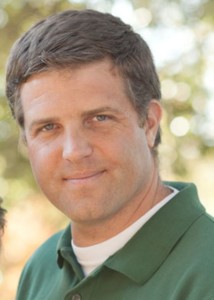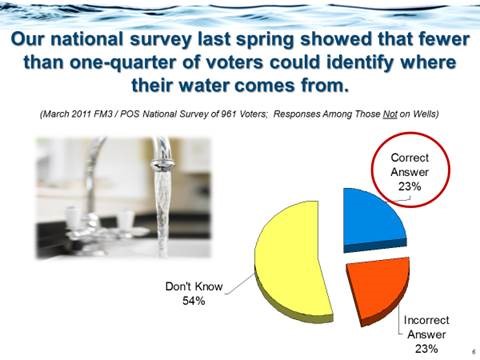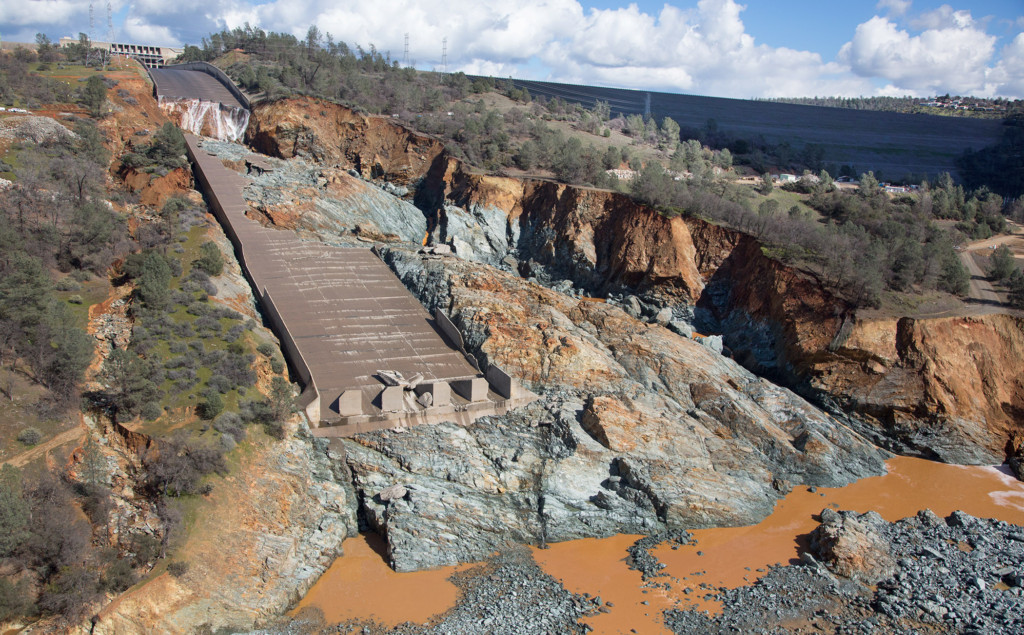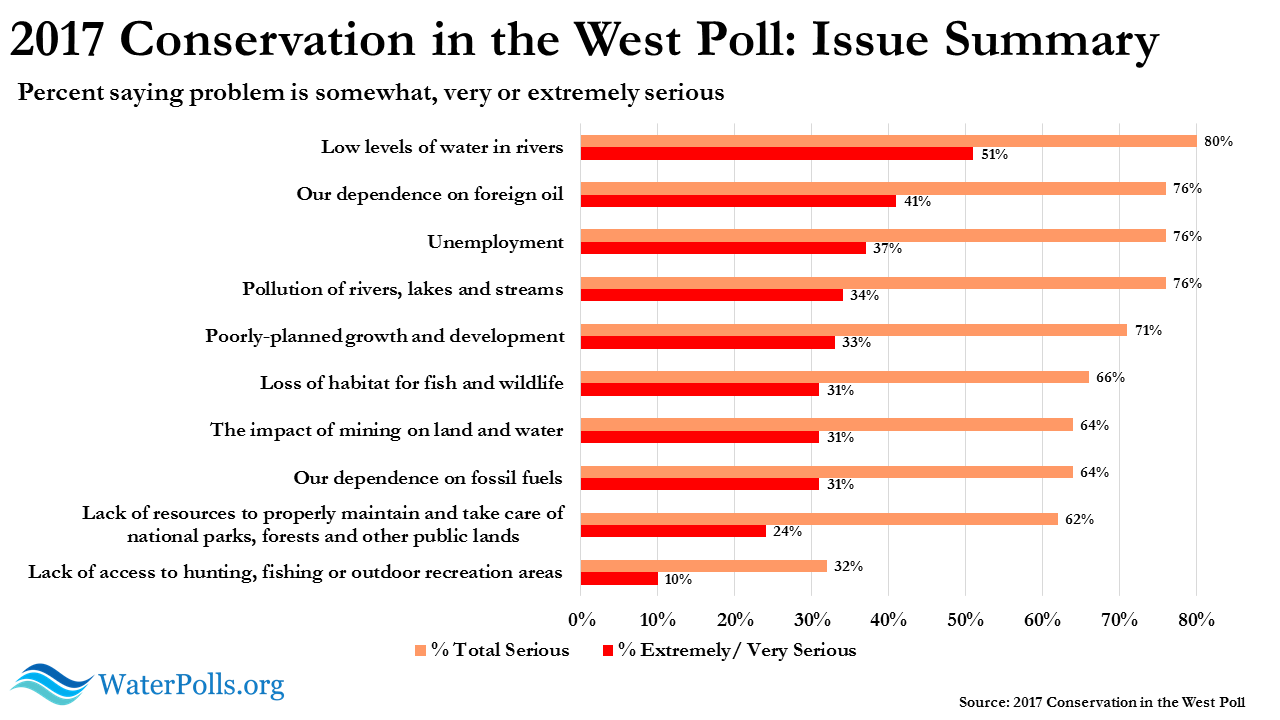Q&A: my interview with pollster Dave Metz
Dave Metz is one of the nation’s leading experts on public opinion related to water and other natural resource issues. Metz, a partner at Fairbank, Maslin, Maullin, Metz & Associates, has provided opinion research and strategic guidance to hundreds of non-profits, government agencies, businesses, and political campaigns in all 50 states. I spoke with him recently about polling on water issues and what the research says about how to communicate about water challenges and solutions.
Compared to other issues you research, what’s most notable or interesting about polling related to water?
Probably the most striking thing is that it’s a bipartisan issue. With so many issues, whether you’re a Democrat or Republican, you see the world very differently. Water is one issue that really cuts across those lines. It has a remarkable degree of consistency between voters on the left and voters on the right, in terms of both how we view some of the challenges as well as potential policy solutions to address them.
Why is it so bipartisan, given that so many issues today are the opposite?
It has to do with the fundamental importance that water has for everyone. We all need clean water to drink. It is vital, and equally so to all Americans, regardless of their partisan background. Many voters believe that the single most important thing that government does is ensure a reliable supply of safe drinking water. As a result, the urgency with which voters view the issue, and their willingness to pay more taxes or support regulation or other public policy interventions they might be squeamish about in other contexts, varies less across partisan lines on water than on other issues.
Many polls have shown Americans to be concerned about water. What in particular troubles the public? Pollution? Drought? Cost? Climate Change?
On a day-to-day basis, there isn’t a lot that really troubles them. Americans generally feel like their water quality is pretty good and their water supply is reliable. Bodies of water are perceived as relatively healthy in most cases. But what is urgent for them is making sure that it stays that way. The second there’s a hint of any real threat to water quality or the water supply, they tend to be very supportive of policies that do something about it.
This obviously varies from time to time and from place to place. When a significant water quality issue emerges, as in Flint, it instantly becomes very galvanizing and focuses people’s attention. That becomes the thing they really want to see addressed. Similarly, in times of drought, that issue really becomes dominant, as it was in California over the past couple of years. But it quickly recedes once the immediate sense of emergency is gone.
Among the various things that may move people to be more concerned about water, it is water quality, first and foremost, and supply secondarily, that are the biggest areas of concern. Climate change is far below either or those—and frankly that is a place where there is partisan polarization. Democrats are vastly more likely to view climate change as a problem or something that requires action than Republicans.
How well does the public understand water issues?
I think they understand it from the perspective of how it impacts their day-to-day life. They need water to drink and to serve their household needs. But they don’t really understand the process by which water gets to them, how it’s treated, and where it comes from.
We did a national survey a couple of years ago where we asked people to identify the original source for the water they use in their home. We recorded what they told us verbatim and went back and looked up the correct answer. Nationally, about 25 percent of voters were able to correctly identify where their water came from, 50 percent told us they had no clue, and roughly 25 percent identified a source that was incorrect. So, the public is not coming to this from a real solid base of knowledge about where water comes from and what it means for their community.
Are there significant racial, gender, or other demographic differences in how Americans think about water?
Not huge ones. I think the similarities are greater than the differences. On this, as on many other issues, women express higher levels of concern more often than men do. They tend to be more risk-sensitive and if there is a potential threat, they’re much more likely to want something done about it. Some communities of color are more likely to perceive that their water quality is worse than in neighboring communities that are perhaps whiter. But these are exceptions to the general rule that the demographic similarities are much greater than the differences.
Some polling suggests that non-white and lower-income Americans are more concerned about their water. Why is that?
There are two factors. In some places, it reflects the objective reality. There’s a greater presence of sources of pollution and potential contaminants of water in many lower-income communities and communities of color. Second, it reflects a broader feeling among those communities that, on any of a range of public services, they’re given short shrift and neglected in ways that more affluent and whiter communities are not.
For decades, pollsters have found declining levels of trust in a variety of American institutions. Does this play into water issues and explain why so many Americans are worried about their water?
There’s no doubt that Americans have lost trust in a wide range of big institutions: the government, the press, organized region, the media, business, labor. They’re all viewed with a lot more suspicion and cynicism than had been the case before. If you were to ask people how they feel about elected officials or public agencies that are in charge of managing their water supply—government broadly written—I think you’d see the same kind cynicism or lack of confidence. But we usually find that when we ask about specific agencies that are tasked with managing water resources—and ask about them by name—they actually have high degrees of credibility with the public.
Once we separate it from electoral politics—we’re not talking about your city council member or congressman but we’re talking about the state department of water resources or the city water agency—the level of confidence is higher because people’s instinct is that these are non-partisan professionals with some degree of technical expertise who are making decisions based on what’s best for the community and not a political agenda.
Obviously, it can vary from place to place. In communities where there’s a history of problems with water quality, local water agencies are probably going to be viewed with more distrust. But, in general, there’s not the same reflexive cynicism when we’re talking about a specific water agency.
How big of an effect has the lead poisoning in Flint, Michigan had on national public opinion related to water?
We did a survey in California a couple months ago and asked whether people had heard anything about Flint and how serious a problem it was. This is 2,000 miles away and two years after the fact, but almost everybody had heard something about it and viewed it as a serious problem. That’s pretty remarkable: the durability of concern about a localized problem like that over both time and distance. I’m not sure it has produced a dramatically different set of public positions on the issues, but it certainly has provided a focus for why it’s so important to make sure things don’t go wrong.
What about the California drought—and the recent switch to wet weather?
It certainly had an effect on the urgency with which people view the issue. A year-and-a-half ago, the drought was the number one concern on Californians’ minds by far. Now, water issues have fallen back to mid-tier. When we ask Californians whether the end of the drought means our water supplies are sufficient, or whether we still face an ongoing shortage that means we’re going to need to take steps to address our long-term water supply, they choose the latter. They’ve been in and out of enough droughts, if they’ve lived in California for any period of time. They know another drought will come along and that the population is not shrinking, but growing—and our infrastructure isn’t getting any stronger. So, all of that leads them to believe, at least in the abstract, that we can’t relax our vigilance and we still need to address the issue.
What does the public think about potential solutions to water problems, such as increasing conservation and changing water laws?
To some degree they point the finger at the public broadly and their neighbors specifically. They believe that members of the public don’t make efficient use of water and could do more to conserve it. Generally speaking, they’re making reference to that parking lot down the street where the sprinkler is always watering the asphalt, and their neighbor who they know takes really really long showers. They’re less likely to say I, myself, am doing some really bad things and need to be more mindful of conserving water myself.
That said, the value of conservation is one that they hold very highly. They believe that the first thing we ought to do when it comes to addressing water needs is make the best possible use of existing supplies, as opposed to taking major steps to develop new ones. If there are public policy interventions that start with the notion that businesses and individuals should be responsible with their use of water, they tend to get very strong support.
Another set of solutions that gets strong support involves improving infrastructure. We just did a poll for the Value of Water Campaign that showed very strong support for investments in infrastructure. I don’t think that’s unique to water. The public thinks we’re under-investing in infrastructure of all kinds right now and water infrastructure is no exception.
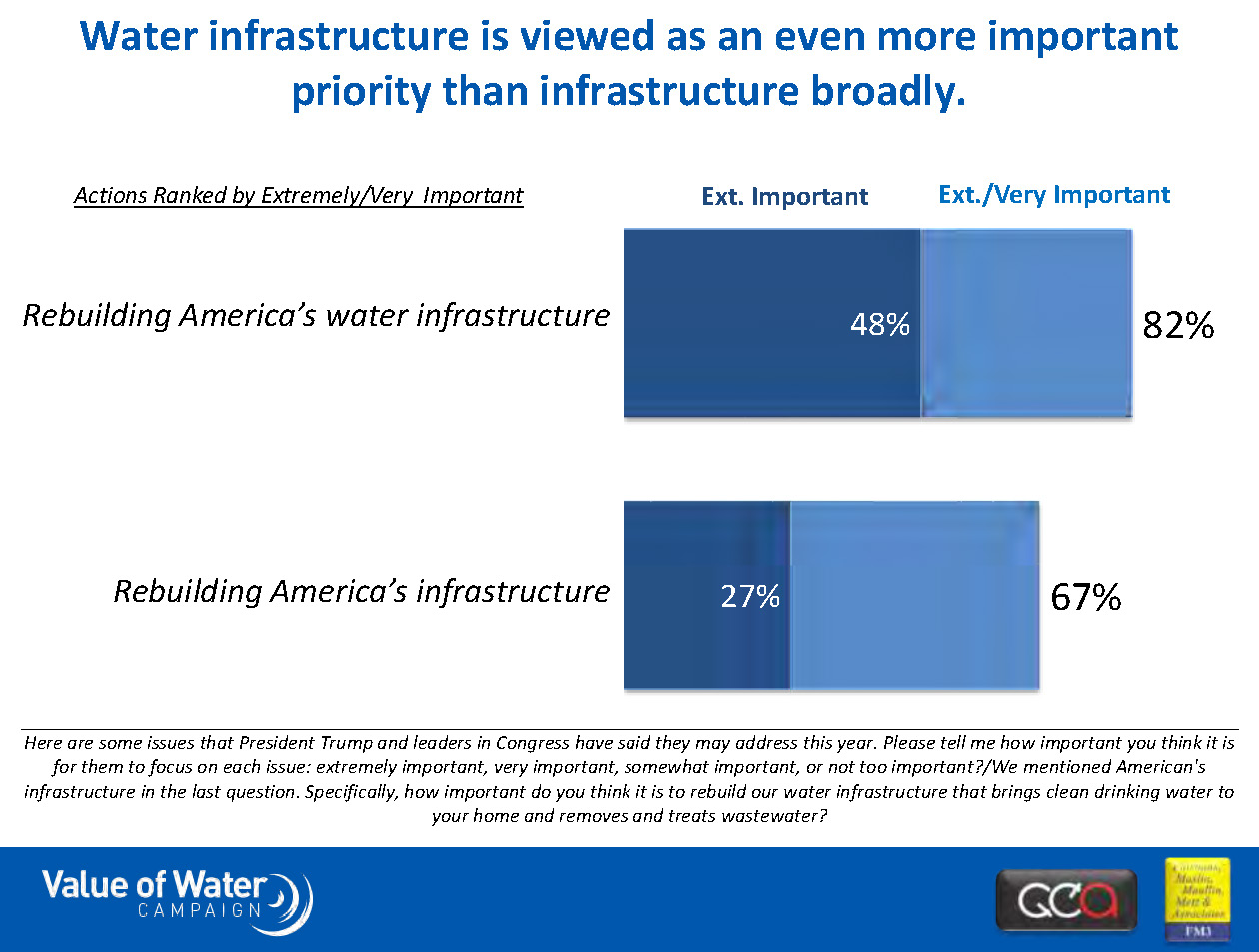
Source: Value of Water Campaign
When we start talking about other ways of expanding water supplies, things like recycled water and desalination, those issues become a little more divisive for the public. They are supportive in concept, but want to know how much it costs and the relative benefit that each one provides.
When we get down to straightforward water rate increases to continue providing the same level of service—that’s where there’s the greatest public skepticism.
Spending on infrastructure seems to have very strong bipartisan support. What’s the best way to message the need for the work—and the need for someone to pay for it?
Number one is highlighting the vulnerability of that infrastructure. Things may be working fine today, but we’re one earthquake or severe weather event away from that infrastructure failing—with devastating consequences. Even raising the specter that you could be without water for three or four days while people work to repair or replace it—people can instantly understand how disruptive that could be. So you don’t have to overhype the issue or paint it in terms that are too dark. On their own, people will get there and say this is pretty vital.
A second thing is highlighting the age and condition of the infrastructure. People know it’s not just water, it’s roads, it’s schools, it’s hospitals—in any number of areas, they can see the way physical structures that serve important public needs are deteriorating. It’s saying it has been 100 years since we built this system and it hasn’t had significant upgrades, so it’s time.
The third key element of messaging on infrastructure is images: being able to show people pictures when systems are failing or when they’re not in the condition they should be. Being able to show them something that looks like it’s close to collapse—that can be worth more than any fact- or statistic-packed verbal message you might craft.
The images of Oroville Dam crumbling certainly were compelling and hard to beat with a sound bite. Any other interesting findings from the infrastructure poll? It was striking how ubiquitous the support was.
It reflects the same patterns in public opinion that lead to infrastructure being talked about as the one arena for potential cooperation between Trump and Democrats in Congress. The issue is so nonpartisan. What we see in the water infrastructure poll data is being translated into the political conversation, with both sides of the aisle saying if there’s one thing we ought to be able to come together on, it’s infrastructure.
Have the November election and the early days of the Trump administration changed public opinion related to water or environmental issues in any significant way?
No, not that I would point to. We do a lot of polling on environmental issues and just last week we were in Washington presenting findings from the State of the Rockies Poll we do in seven states in the Interior West. We’ve done polling that has spanned the Obama administration and now the Trump administration. Essentially, there are no meaningful changes in the results over that period of time. I can’t think of an environmental issue where, independent of other events, I saw the level or concern or support for specific solutions change just based on who was in the White House.
Whom do people trust on water issues? Farmers? Utilities? Government? Scientists? NGOs?
A little bit of all of the above. Probably the best messenger we’ve found over time is water quality scientists: people who have neutral expertise on the issue and are totally non-ideological in recommending a certain action.
Farmers are also very high on the list. I remember doing focus groups where people told us we can trust farmers, they would never waste a drop of water because it’s too vital to their way or life and livelihood—not recognizing that, as in most sectors, there can be an enormous waste of water in agriculture. But farmers are seen as very credible messengers on the issue. Native American tribes also sometimes score very high. Public agencies that are specifically tasked with managing water resources actually tend to poll very well.
What are the challenges and opportunities for people who communicate about water issues? What messages resonate?
The main challenge is that water quality is like the offensive line in a football game. The players know they are doing a good job when no one calls their name and they’re not getting any attention whatsoever. It’s when they make a mistake that the announcers suddenly start talking about them.
Water is the same: when things are going well and water managers are doing their job, it’s not an issue to which the public pays a lot of attention. Getting people to focus on it in the absence of a crisis can be a challenge.
Fortunately, there is an array of messages that have been effective in motivating people for action: Talking about the public health issues involved. If there is a problem, specifying the nature of the problem or threat. Even in the absence of an immediate threat, being able to say if we don’t take action to maintain our system, these are the kinds of problems that could emerge and the way they would threaten human health.
When we’re talking about bodies of water and surface water, generational messages, saying we need to protect and preserve this body of water for everything it provides to our community and making sure our children and grandchildren can benefit from it the way we do. As on many environmental issues, that message is pretty effective.
We’ve been testing more and more the notion of the value of water. It’s the idea that what the average resident pays to have clean, safe drinking water available in their house 24 hours a day, compared to what they pay for the same amount of milk, Diet Coke, gasoline, or bottled water, demonstrates a remarkable value. Framing the issue that way, in those comparative terms, can make people a lot more comfortable with their water rates, and a little more appreciative of both the resource and the infrastructure that’s in place to deliver it to their homes.
What are the gaps in our knowledge of public opinion about water? What are you curious to know more about?
Probably the biggest area for exploration is around a lot of the new technologies that are becoming more prevalent for addressing water supply needs—things like potable reuse and desalination. There’s been a reasonable amount of research done on those issues and a lot of good guidance on how to talk about them, but we still find there’s a lot the public doesn’t understand about them and they have some instinctive aversion to potable reuse, for example. There’s more we can do to figure out how to push past that and get to a higher degree of public comfort.
Another area where we’ve struggled is nitrogen pollution, which is becoming an increasing problem in a lot of different places but has effects that are not immediately evident to the average person and causes that are generally diffuse. It’s generally not an issue that immediately poses a threat to public health, and there’s rarely one bad actor we can point to and say, “just stop them from polluting and everything will be fine.” Figuring out how to talk about that issue in more compelling way, reflecting the challenges faced by different communities, would be helpful. It’s not that there’s been no research on these subjects, but we haven’t found any magic formula where we can say “we have a playbook, we know how to handle this, and there’s nothing else to figure out.”
How well do we understand public opinion on water compared to other political issues?
I don’t know that it’s drastically better or worse than other issues. Because there are a lot of agencies who have major responsibilities for addressing it, there are good, reliable sources for funding to conduct helpful opinion research. So I don’t know if we’re any worse off in understanding the public’s thinking than we are on subjects like education, transportation, or health care. But like those issues, water has a lot of complexities, especially the more you delve into the details of specific policies, so there’s always more we can learn.
This May 18, 2017 interview was edited lightly for clarity and brevity.
WaterPolls.org aggregates, analyzes, and visualizes public opinion data on water-related issues. Stay informed via Twitter, Facebook, Pinterest, RSS, and email.


